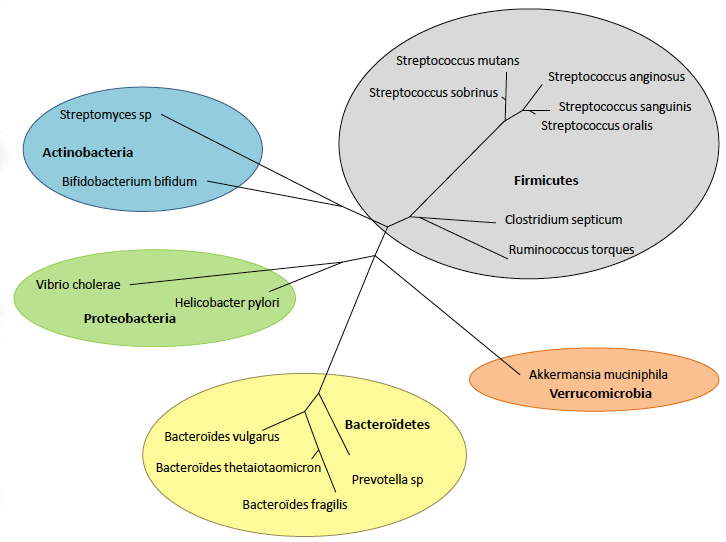Our inner universe;
The microbiota
Are we carrying 3.9×10 13 bacteria (39,000 billion) [1] weighing nearly 2 kg or are we hybrids half-human half-bacterial? After all, our body is composed of 3×10 13 cells so fewer cells than bacteria! About 500 to 1,000 [2] different strains are found in humans.
Ninety-nine percent of our intestinal bacteria is unable to use oxygen. These are called anaerobes. This is important because most probiotics (90%) come from anaerobic strains but have the ability to survive in capsule. This is the case of acidophilus which composition of the majority of probiotics on the market. However, they have little long-term effect on the anaerobes that mainly determine our health by a permanent change in the microbiota. A better strategy is to grow our own bacteria by giving them prebiotics and probiotics, a so-called symbiotic. [3], [4] Fermented foods (sauerkraut, etc.) and with bacteria (like yogurt and Kefir) also promote a balanced microbiome.
There is now a new class of fermented symbiotics in the form of supplements, which results from a combination of fungus and microbe that can be found in kombucha or soy or dairy kefir. “This ferment is formed by a symbiosis of yeasts and bacteria coated in a matrix of polysaccharides produced naturally by the so-called symbiosis. “[5]
Excessive hygiene and the prevalence of diseases
The microbiota of Westerners has been examined by Dr. Molly’s team at the University of Cambridge.
They first noted the prevalence of parasitic infections and the biodiversity of intestinal bacteria among people in 192 countries. Next, they noted the rate of onset of Alzheimer’s disease. [6] Where hygiene measures are the most developed, there has been a higher prevalence of Alzheimer’s cases.
It is understood that the correlation of two parameters is not enough to link these elements by simple observation, but it is a beginning of research that feeds the thesis of the importance of a balanced microbiota.
A balanced and healthy microbiota
But what is a balanced and healthy microbiota that allows the expression of radiant health?
It is not a microbiota affected by sugar, fatty foods, trans fat and interesterified fatty acids and glycated proteins (Europe). It is also not a microbiota modified by antibiotics, contraceptive pill and hormonal treatment, anti-inflammatories, laxatives, proton pump inhibitors and Metformin, a hypoglycemic agent for diabetics. There are at least 19 classes of drugs that clearly demonstrated a harmful action on the microbiota.
The hidden secret: fibers!
A healthy microbiota has been fed fiber (vegetables, fruits, legumes and whole grains (Africa)), nuts, and foods rich in polyphenols including dark chocolate, tea, coffee and red wine. Even beer would have a beneficial effect on the growth of good bacteria!
It is a diverse microbiome and with more bacteria of the type Bacteroides and less of type Firmicutes as can be seen in the comparative study between microbiota of children of Burkina Faso (A) and children of Italy (B) [8]. Food changes everything!
This is also revealed by two major studies on healthy microbiota in 2,000 participants, one in Belgium and the other in the Netherlands, published in 2016. [9]
“For the benefit of future clinical studies, it is essential to establish what constitutes a “normal” intestinal microbiome, if it exists. Through fecal samples and questionnaires, Falony et al. and Zhernakova et al. targeted general populations in Belgium and the Netherlands, respectively. The composition of the gut microbiota is correlated with a range of factors including diet, drug use, red blood cell count, fecal chromogranin A and stool consistency. The data provides some guidance for possible biomarkers of normal intestinal communities. “[10]
In summary, when we observe a greater diversity of healthy Bacteroides type bacteria unlike unhealthy Firmicutes type bacteria, we obtain a healthy microbiota.
The health of the microbiota is closely related to the intestinal mucosa.
Fragility of the intestinal mucosa
When the intestinal wall is inflammed, the protective lining of intestinal antibodies may be lost. With the loss of Secretory Immunoglobulin A (SigA), the body becomes more vulnerable to intestinal infections from bacteria, viruses, parasites and yeasts. Some Gram-negative bacteria secrete endotoxins; lipopolysaccharides (LPS). These pass through the two barriers of the intestines and the brain and can lead to severe symptoms of depression, chronic fatigue syndrome, autism and ALS (Amyotrophic Lateral Sclerosis), and Alzheimer’s. They can also reach other organs and promote type 2 diabetes, non-alcoholic liver cirrhosis and inflammatory bowel diseases.
Stress also increases this hyperpermeability. [11]
Thanks to the work of Dr. Fasano [12] on the intestinal permeability and the pre-haptoglobin 2/Zonulin marker, it is certain that gluten gliadin, casein (variant A1 beta-casein portion) of dairy products, is Sugar and alcohol, as well as several foods containing lectins such as legumes, cereals and solanaceae (tomato, pepper, potato and eggplant) can increase intestinal permeability in most humans. [13]
Cooking, soakin sprouting and fermentation reduce the amount of lectins present in these foods.
Stress also increases intestinal permeability. “Stress stimuli activate the Sympathetic Nervous System (SNS) and the Hypothalamic-Pituitary-Adrenal (HPA) axis. Activation of both systems increases the availability of water, minerals and energy-rich substances to meet the metabolic demands of the body. “[14]
Promoting microbiota balance
It is not necessary to use parasites to restore the balance of the microbiota and the immune system. Rather, it is to promote microbiota balance through diet and micronutrition with synbiotics, nutrients that promote healthy intestinal mucosal integrity, and an effective stress modulation program.
This symbiotic balance can be supported by acting on the intestinal mucosa as well as on the probiotic population.
Synbiotics that are derived from fermentation in an already equilibrium environment (fermented probiotics such as soybean and kefir) not only promote intestinal health at the time of product uptake, but also a sustainable increase in the population of microbiota.
Essential fatty acids and fat-soluble vitamins such as vitamin A and D not only promote the repair and hydration of the intestinal mucosa, but also the balance between Th-1 and Th-2.
Micronutrients such as l-glutamine (which mainly feeds enterocytes), zinc, n-acetyl-glucosamine, licorice, marshmallow, aloe, slippery elm, cat’s claw, pectin and fiber prebiotics (for short chain fatty acids including butyrate which feeds colonocytes): they are found in vegetables and fruit, especially in chicory, dandelion, Jerusalem artichoke, garlic, onions, leeks, bananas, apples, cocoa, burdock, konjac and yacon roots, flaxseeds, legumes, cereals and seaweeds.
To fight against parasitosis, there are several compounds of medicinal plants, but all have the disadvantage of causing symptoms related to the destruction of parasites. This kind of inconvenience is avoided when using specific proteolytic enzymes and/or highly specialized homeopathic products offered by some companies or fermented medicinal plants like oregano, thyme, clove and garlic.
Fecal transplant
When the disease is at an advanced stage, it may be wise to consider a fecal transplant. A healthy, whole microbiota from a donor provided with its entire ecosystem already in equilibrium can radically restore the equilibrium of this environment which can sometimes be so disturbed that it is better to start anew. Until now, fecal transplants alone do not allow a permanent and lasting change in the healthy microbiota. In my opinion, to maintain change, it is essential to adopt a lifestyle that promotes good eating habits and modulates stress: high-fiber, low-sugar, bad-fat, and overheated protein sources of food. breathing through the nose!
Fecal transplantation is currently officially allowed only for cases of contamination with Clostridium Difficile causing severe diarrhea.
Some researchers, such as Dr. Thomas J. Borody [15] have observed spectacular results for myasthenia gravis, and evidence for Multiple Sclerosis, Parkinson’s disease, autism and Alzheimer’s.
Conclusion
In summary, the understanding of a healthy microbiota, in relation to its environment, will allow us to specify what promotes general health beyond the aseptic thinking related to the obsession with cleanliness as we live in America North.
After all, are not we half man and half bacterial since we are made up of a few more bacteria than cells?
“You can think of yourself as a human individual carrying microbes. Alternatively, you can also see yourself as a superorganism – a cooperative colony of cells, some of which are human, but most are microbes.
The exploration of this universe of the living microcosm is still in its infancy. He invites us to keep an open mind about future discoveries that may surprise us!
References
[1] https://www.sciencesetavenir.fr/sante/flore-bacterienne-humaine-le-chiffrage-du-microbiote-etait-faux_29779
[2] Sommer, F; Bäckhed, F (Apr 2013). “The gut microbiota–masters of host development and physiology”. Nat Rev Microbiol. 11 (4): 227–38. doi:10.1038/nrmicro2974. PMID 23435359.
[3] The association between a probiotic and a prebiotic, a nutrient that is favorable to it, is called a synbiotic.
[4] http://www.jydionne.com/probiotiques-prebiotiques-et-synbiotiques/
[6] M Fox et al. Hygiene and the World Distribution of Alzheimer’s Disease, Evol. Med. Publ. Health, 2013, doi : 10.1093/emph/eot015
[7] http://www.sciencemag.org/news/2016/04/parasitic-worms-may-prevent-crohn-s-disease-altering-bacterial-balance
[8] De Filippo et al. 2010. Impact of diet in shaping gut microbiota revealed by a comparative study in children from Europe and rural Africa ( http://www.pnas.org/content/107/33/14691.full )
[9] Zhernakova, A. Kurilshikov, M. J. Bonder et coll. Population-based metagenomics analysis reveals markers for gut microbiome composition and diversity. Science, 2016 ; 352 (6285) : 565 DOI:10.1126/science.aad3369 ET
Falony, M. Joossens, S. Vieira-Silva, et coll. Population-level analysis of gut microbiome variation. Science, 2016 ; 352 (6285) : 560 DOI : 10.1126/science.aad3503[9] http://www.sciencemag.org/news/2016/04/parasitic-worms-may-prevent-crohn-s-disease-altering-bacterial-balance
[10] Science 29 Apr 2016:Vol. 352, Issue 6285, pp. 565-569. DOI: 10.1126/science.aad3369
[11] https://www.ncbi.nlm.nih.gov/pmc/articles/PMC4432792/ et Dr Perlmutter dans L’intestin au secours du cerveau. Marabout. 2016.
[15] TJ Borody et al. Therapeutic faecal microbiota transplantation : current status and future developments. Curr. Opin. Gastroenterol. 30, no.1 (Jan. 2014) : 97-105, doi : 10.1097/MOG.0000000000000027.



Recent Comments